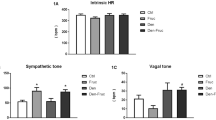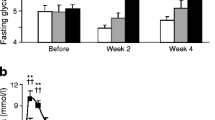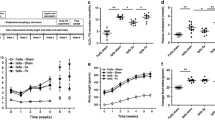Abstract
The aim of the present study was to assess the metabolic adjustments in adult rats with autonomic imbalance induced by hypercaloric diet. Male Wistar rats (4 weeks of age) were fed a chow diet (CD, n = 12) or hypercaloric diet (HD, n = 13) for 19 weeks. Body weight and dietary intake were measured every week and the basal metabolic rate was assessed. After 19 weeks of diet, six animals from each group were anesthetized with a lethal dose of barbital sodium (100 mg/Kg body weight, intraperitoneal; i.p.). Lee index was evaluated and adipose pads weighted. The remaining animals had a silastic cannula placed into the jugular vein for drug administration, blood collecting, and hemorrhage (1.2 mL/100 g bw/2 min). A polyethylene catheter (PE50) was inserted into the abdominal artery through the femoral artery for cardiovascular monitoring. The assessment of autonomic balance was done by evaluation of baroreflex sensitivity (intravenous (IV) injection of phenylephrine and sodium nitroprusside) and hemorrhage (1.2 mL/100 g bw/2 min). As expected, the HD induced obesity; increased weight gain (28%), adipose pads weight, and baroreflex dysfunction. The plasma level of free fatty acids and triacylglycerols were increased in HD rats by about 124% and 424%, respectively, as well as the basal metabolic rate measured at 19th weeks of diet (p < 0.01). We observed that baroreflex sensitivity to phenylephrine was reduced by about 50%, and the hyperglycemic response to hemorrhage hypotension was increased by 128% in HD rats. We found also a negative correlation between the alteration in baroreflex sensitivity and the increase in hyperglycemic response to hemorrhage in the obese rats (r = 0.72, p < 0.01) and a strong positive correlation between the increased Lee index and the hemorrhagic hyperglycemia (r = 0.93, p < 0.01). Our data demonstrate that obesity induced by hypercaloric diet in Wistar rats promotes an autonomic imbalance, which interferes with metabolic responses dependent on baroreflex sensitivity. In addition, we showed the existence of close correlation between the loss of baroreflex sensitivity and the degree of obesity.






Similar content being viewed by others
References
Barnes MJ, Lapanowski K, Conley A, Rafols JA, Jen KL, Dunbar JC (2003) High fat feeding is associated with increased blood pressure, sympathetic nerve activity and hypothalamic mu opioid receptors. Brain Res Bull 61(5):511–519
Boustany CM, Bharadwaj K, Daugherty A, Brown DR, Randall DC, Cassis LA (2004) Activation of the systemic and adipose renin–angiotensin system in rats with diet–induced obesity and hypertension. Am J Physiol Regul Integr Comp Physiol 287(4):R943–R949
Bunag RD, Krizsan D, Itoh H (1990) Diminished cardiovascular responsiveness to vagal stimulation in obese rats. Am J Physiol Regul Integr Comp Physiol 259:R842–R848
Bunag RD, Meyer M, Vansell N, Kerecsen L (1996) Conscious obese rats have impaired reflex bradycardia and enhanced norepinephrine sensitivity. Am J Physiol Regul Integr Comp Physiol 271:R654–R660
Carroll JF, Zenebe WJ, Strange TB (2006) Cardiovascular function in a rat model of diet–induced obesity. Hypertension 48(1):65–72
Coimbra CC, Garófalo MAR, Fócolo DRC, Xavier AR, Migliorini RH (1999) Gluconeogenesis activation after intravenous angiotensin II in freely moving rats. Peptides 20:823–827
Correia ML, Morgan DA, Sivitz WI, Mark AL, Haynes WG (2001) Leptin acts in the central nervous system to produce dose–dependent changes in arterial pressure. Hypertension 37(3):936–942
Dunbar JC, Hu Y, Lu H (1997) Intracerebroventricular leptin increases lumbar and renal sympathetic nerve activity and blood pressure in normal rats. Diabetes 46:2040–2043
Du Toit EF, Nabben M, Lochner A (2005) A potential role for angiotensin II in obesity induced cardiac hypertrophy and ischaemic/reperfusion injury. Basic Res Cardiol 100(4):346–354
Elmquist JK (2001) Hypothalamic pathways underlying the endocrine, autonomic, and behavioral effects of leptin. Physiol Behav 7 4(4–5):703–708
Grassi G (2004) Leptin, sympathetic nervous system, and baroreflex function. Curr Hypertens Rep 6:236–240
Hall JE, Hildebrandt DA, Kuo J (2001) Obesity hypertension: role of leptin and sympathetic nervous system. Am J Hypertens 14(6 pt 2):103S–115S
Hausberg M, Morgan DA, Chapleau MA, Sivitz WI, Mark AL, Haynes WG (2002) Differential modulation of leptin–induced sympathoexcitation by baroflex activation. J Hypertension 20:1633–1641
Himms-Hagen J (1984) Nonshivering thermogenesis. Brain Res Bull 12:151–160
Himms-Hagen J, Triandafillou J, William GC (1981) Brown adipose tissue of cafeteria–fed rats. Am J Physiol Endocrinol Metab 241:E116–E120
Koyama Y, Coker RH, Stone EE, Lacy DB, Jabbour K, Williams PE, Wasserman DH (2000) Evidence that carotid bodies play an important role in glucoregulation in vivo. Diabetes 49:1434–1442
Koyama Y, Coker RH, Denny JC, Lacy DB, Jabbour K, Williams PE, Wasserman DH (2001) Role of carotid bodies in control of the neurendocrine response to exercise. Am J Physiol Endocrinol Metab 281:E742–E748
Lee MO (1929) Determination of the surface area of the white rat with its application to the expression of metabolic results. Am J Physiol 89:24–33
Levin BE (1994) Diet cycling age alters weight gain and insulin levels in rats. Am J Physiol Regul Integr Comp Physiol 267(2 pt 2):R527–R235
Levin BE, Dunn-Meynell AA, Balkan B, Keesey RE (1997) Selective breeding for diet induced obesity and resistance in Sprague Dawley rats. Am J Physiol Regul Integr Comp Physiol 273(2 pt 2):R725–R730
Lohmeier TE, Warren S, Cunningham JT (2003) Sustained activation of the central baroreceptor pathway in obesity hypertension. Hypertension 42(1):96–102
Machado LJ, Marubayashi U, Reis AM, Coimbra CC (1995a) Effect [1-sar, 8-thr]—angiotensin II on the hyperglycemic response to hemorrhage in adrenomedullated and guanethidine–treated rats. Regul Pep 60(1):69–77
Machado LJ, Mihessen-Neto I, Marubayashi U, Reis AM, Coimbra CC (1995b) Hyperglycemic action of angiotensin II in freely moving rats. Peptides 16(3):479–483
Mihessen-Neto I, Reis AM, Marubayashi U, Coimbra CC (1996) Effect of sympathoadrenal blockade on the hyperglycemic action of angiotensin II. Neuropeptides 30(3):303–308
Miller AW, Sims JJ, Canavan A, Hsu T, Ujhelyi MR (1999) Impaired vagal reflex activity in insulin–resistant rats. J Cardiovasc Pharmacol 33(5):698–702
Palkovits M, Baffi JS, Pacak K (1999) The role of ascending neuronal pathways in stress–induced release of noradrenaline in the hypothalamic paraventricular nucleus of rats. J Neuroendocrinol 11(7):529–539
Park SY, Lee YJ, Kim HJ, Doh KO, Lee MK, Kim JY, Lee SK (2000) Change in activity of the sympathetic nervous system in diet induced obese rats. J Korean Med Sci 15(6):635–640
Schwartz MW, See Ley RJ, Campfield LA, Burn P, Baskin DG (1996) Identification of targets of leptin action in rat hypothalamus. J Clin Invest 98(5):1101–1106
Shih CD, Au LC, Chan JYH (2003) Differential role of leptin receptors at the hypothalamic paraventricular nucleus in tonic regulation of food intake and cardiovascular functions. J Biol Sci 10:367–378
Silveira SA, Viana Lima NR, Haibara AS, Coimbra CC (2003) The hypothalamic paraventricular nucleus and carotid receptors modulate hyperglycemia induced by hemorrhage. Brain Res 993:183–191
Silveira SA, Haibara AS, Coimbra CC (2005) Hyperglycemic response to hemorrhage is modulated by baroreceptors unloading but not by peripheral chemoreceptors activation. Auton Neurosci. 123:36–43
Strack AM, Sawyer WB, Platt KB, Loewy AD (1989) CNS cell groups regulating the sympathetic outflow to adrenal gland as revealed by transneuronal cell body labeling with pseudorabies virus. Brain Res 491(2):274–296
Tan PS, Killinger S, Horiuchi J, Dampney RA (2007) Baroreceptor reflex modulation by circulating angiotensin II is mediated by AT1 receptors in the nucleus tractus solitarius. Am J Physiol Regul Integr Comp Physiol 293(6):R2267–R2278
Van Dijk G, Thiele TE, Donahey JC, Campfield LA, Smith FJ, Burn P, Bernstein IL, Woods SC, Seeley RJ (1996) Central infusions of leptin and GLP-1-(7–36) amide differentially stimulate c-FLI in the rat brain. Am J Physiol Regul Integr Comp Physiol 271(4 Pt 2):R1096–R1100
Zincker BA, Namdaran K, Wilson R, Lacy DB, Wasserman DH (1994) Acute adaptation of carbohydrate metabolism to decreased arterial PO2. Am J Physiol Endocrinol Metab 266:E921–E929
Acknowledgements
The authors thank CNPq, CAPES, FAPESP and FAPEMIG for financial support. The technical assistance of André Luis Pimenta de Faria, Janine Costa Ivo and Patrícia Andrade Guimarães Mitre are also acknowledged.
Author information
Authors and Affiliations
Corresponding author
Rights and permissions
About this article
Cite this article
de Lima, D.C., Silveira, S.A., Haibara, A.S. et al. The enhanced hyperglycemic response to hemorrhage hypotension in obese rats is related to an impaired baroreflex. Metab Brain Dis 23, 361–373 (2008). https://doi.org/10.1007/s11011-008-9101-x
Received:
Accepted:
Published:
Issue Date:
DOI: https://doi.org/10.1007/s11011-008-9101-x




